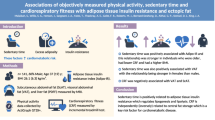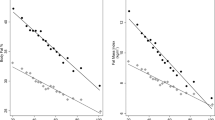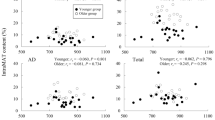Abstract
We hypothesised that strict inactivity (bed rest) would lead to regional differences in fat deposition. Twenty-four male subjects underwent 60d bed rest and remained inactive (n=9), performed resistance exercise plus whole-body vibration (RVE; n=7) or resistance exercise only (RE; n=8). Fat mass was assessed via dual X-ray absorptiometry. In the inactive subjects, fat deposition differed between body regions (P=0.0005) with android region visceral adipose tissue increasing the most (+29% at the end of bed rest), followed by remainder of the trunk (from chin to the iliac crest; +10%) and the arms and legs (both +7%). Insulin sensitivity reduced in the inactive subjects at the end of bed rest (P=0.036). RE did not have a significant impact on regional fat mass changes (P⩾0.055). In RVE, increases in visceral adipose tissue (−14%; P=0.028 vs inactive subjects) and in the arms (arms −8%, P=0.011 vs inactive) were not seen. We conclude that inactivity leads to a preferential increase in visceral adipose tissue.
This is a preview of subscription content, access via your institution
Access options
Subscribe to this journal
Receive 12 print issues and online access
$259.00 per year
only $21.58 per issue
Buy this article
- Purchase on Springer Link
- Instant access to full article PDF
Prices may be subject to local taxes which are calculated during checkout

Similar content being viewed by others
References
Ross R, Rissanen J . Mobilization of visceral and subcutaneous adipose tissue in response to energy restriction and exercise. Am J Clin Nutr 1994; 60: 695–703.
Goodpaster BH, Kelley DE, Wing RR, Meier A, Thaete FL . Effects of weight loss on regional fat distribution and insulin sensitivity in obesity. Diabetes 1999; 48: 839–847.
Ernersson A, Nystrom FH, Lindström T . Long-term increase of fat mass after a four week intervention with fast food based hyper-alimentation and limitation of physical activity. Nutr Metab (Lond) 2010; 7: 68.
Votruba SB, Jensen MD . Insulin sensitivity and regional fat gain in response to overfeeding. Obesity (Silver Spring) 2011; 19: 269–275.
Booth FW, Gollnick PD . Effects of disuse on the structure and function of skeletal-muscle. Med Sci Sport Exer 1983; 15: 415–420.
Blanc S, Normand S, Ritz P, Pachiaudi C, Vico L, Gharib C et al. Energy and water metabolism, body composition, and hormonal changes induced by 42 days of enforced inactivity and simulated weightlessness. J Clin Endocrinol Metab 1998; 83: 4289–4297.
Kershaw EE . Adipose Tissue as an Endocrine Organ. J Clin Endo Metab 2004; 89: 2548–2556.
Kaul S, Rothney MP, Peters DM, Wacker WK, Davis CE, Shapiro MD et al. Dual-energy X-ray absorptiometry for quantification of visceral fat. Obesity (Silver Spring) 2012; 20: 1313–1318.
Belavý DL, Bock O, Börst H, Armbrecht G, Gast U, Degner C et al. The 2nd Berlin BedRest Study: protocol and implementation. J Musculoskelet Neuronal Interact 2010; 10: 207–219.
Kang SM, Yoon JW, Ahn HY, Kim SY, Lee KH, Shin H et al. Android fat depot is more closely associated with metabolic syndrome than abdominal visceral fat in elderly people. PLoS One 2011; 6: e27694.
Rothney MP, Xia Y, Wacker WK, Martin F-P, Beaumont M, Rezzi S et al. Precision of a new tool to measure visceral adipose tissue (VAT) using dual-energy X-Ray absorptiometry (DXA). Obesity (Silver Spring) 2013; 21: E134–E136.
Möhlig M, Wegewitz U, Osterhoff M, Isken F, Ristow M, Pfeiffer AFH et al. Insulin decreases human adiponectin plasma levels. Horm Metab Res 2002; 34: 655–658.
Riechman SE, Schoen RE, Weissfeld JL, Thaete FL, Kriska AM . Association of physical activity and visceral adipose tissue in older women and men. Obes Res 2002; 10: 1065–1073.
Alibegovic AC, Højbjerre L, Sonne MP, van Hall G, Stallknecht B, Dela F et al. Impact of 9 days of bed rest on hepatic and peripheral insulin action, insulin secretion, and whole-body lipolysis in healthy young male offspring of patients with type 2 diabetes. Diabetes 2009; 58: 2749–2756.
Després JP . Abdominal obesity as important component of insulin-resistance syndrome. Nutrition 1993; 9: 452–459.
Da Silva ME, Fernandez JM, Castillo E, Nuñez VM, Vaamonde DM, Poblador MS et al. Influence of vibration training on energy expenditure in active men. J Strength Cond Res 2007; 21: 470–475.
Artero EG, Espada-Fuentes JC, Arguelles-Cienfuegos J, Roman A, Gomez-Lopez PJ, Gutierrez A . Effects of whole-body vibration and resistance training on knee extensors muscular performance. Eur J Appl Physiol 2012; 112: 1371–1378.
Fjeldstad C, Palmer IJ, Bemben MG, Bemben DA . Whole-body vibration augments resistance training effects on body composition in postmenopausal women. Maturitas 2009; 63: 79–83.
Lamont HS, Cramer JT, Bemben DA, Shehab RL, Anderson MA, Bemben MG . Effects of a 6-week periodized squat training with or without whole-body vibration upon short-term adaptations in squat strength and body composition. J Strength Cond Res 2011; 25: 1839–1848.
Von Stengel S, Kemmler W, Engelke K, Kalender WA . Effect of whole-body vibration on neuromuscular performance and body composition for females 65 years and older: a randomized-controlled trial. Scand J Med Sci Sports 2012; 22: 119–127.
Acknowledgements
The authors wish to thank the subjects who participated in the study, the staff of the Pflegedirektion, the nurses who cared for the subjects and the many colleagues involved in the implementation of the bed rest study. The 2nd Berlin BedRest Study was supported by grant 14431/02/NL/SH2 from the European Space Agency and grant 50WB0720 from the German Aerospace Center (DLR). The 2nd Berlin BedRest Study was also sponsored by Novotec Medical, Charité Universitätsmedizin Berlin, Siemens, Osteomedical Group, Wyeth Pharma, Servier Deutschland, P&G, Kubivent, Seca, Astra-Zeneka and General Electric. Daniel L. Belavý was supported by a post-doctoral fellowship from the Alexander von Humboldt Foundation.
AUTHOR CONTRIBUTIONS
Belavý: Secured funding. Conception and design of the experiments. Statistical analysis and interpretation of the data. Drafting the article. Möhlig: Conception and design of the experiments. Analysis of the data. Revision of article. Pfeiffer: Conception and design of the experiments. Analysis of the data. Armbrecht: Conception and design of the experiments. Analysis of the data. Interpretation of the data. Revision of article. Felsenberg: Secured funding. Conception and design of the experiments. Interpretation of the data. Revision of article.
Author information
Authors and Affiliations
Corresponding author
Ethics declarations
Competing interests
DF acts as a consultant to Novotec Medical for the exploitation of this study’s results. The remaining authors declare no conflict of interest.
Rights and permissions
About this article
Cite this article
Belavý, D., Möhlig, M., Pfeiffer, A. et al. Preferential deposition of visceral adipose tissue occurs due to physical inactivity. Int J Obes 38, 1478–1480 (2014). https://doi.org/10.1038/ijo.2014.26
Received:
Revised:
Accepted:
Published:
Issue Date:
DOI: https://doi.org/10.1038/ijo.2014.26
Keywords
This article is cited by
-
Magnitude of central obesity and associated factors among adult patients attending public health facilities in Adama town, Oromia region, Ethiopia, 2022
Journal of Health, Population and Nutrition (2023)
-
Dose–response effects of aerobic exercise on body composition among colon cancer survivors: a randomised controlled trial
British Journal of Cancer (2017)
-
Whole Body Vibration Improves Insulin Resistance in db/db Mice: Amelioration of Lipid Accumulation and Oxidative Stress
Applied Biochemistry and Biotechnology (2016)



